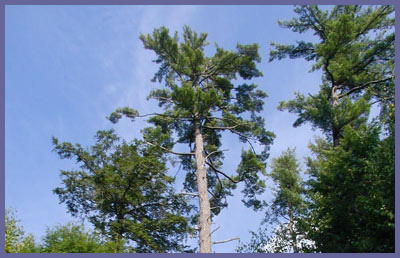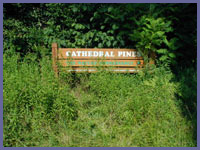
Cathedral Pines (If you know
of updates to this hike please
pass them along. It doesn't see
many people and therefore the
trail is overgrown and the
information presented here could
be outdated.)
This interesting hike offers
forty-two acres of white pines,
hemlocks, and northern hardwoods.
The Cathedral Pines, as they
are known, create a tall ceiling
effect as you walk the path.
(Unfortunately, a tornado
ripped through this very patch of
land in 1989 and did severe damage
to the trees. However, some
of the trees survived and you can
still be awed by their size and
beauty. In fact, part of the
intrigue from this hike comes from
the aftermath of the tornado which
can still be seen today) It
doesn't take much to imagine what
it must have been like before
logging and nature took its toll.
Most of the white pines are
200 years old with some being at
least 300 hundred years. It's
unusual to see a white pine stand
in this part of Connecticut.
The area was set aside and
eventually donated by the Calhoun
family who were the original
landowners of the small parcel of
forest. Scientists are not quite
sure how the stand came to be.
For the hiker, the only
thing you really need to know is
that these are very tall, elegant
trees. It's a very different
hike than what is normally
experienced in Connecticut.
This is one of those trails
that not a lot of people don't
know about but offers some of the
most unique hiking experience in
the Berkshires. It's easy to
get to and easy to explore.
The white pines seen here have
an interesting history behind
them. Because of their
tremendous size and straight
height, the pines were logged for
unique projects. A
contractor in the 1950's was
looking for a stand of slender
white pines over one hundred feet
in height, a maximum of eighteen
inches in diameter at the base,
and a minimum of nine inches at
the tip. Cathedral Pines fit
the bill. The contractor
brought a team of Oneida Indians
to log the pines. They cut
the pines so precisely that each
one fell gently on the next one
until all of them lay softly on
the ground. It was done in
such a way that a tiny saw-whet
owl was found unharmed in one of
the pines. These pines were
logged out of the region and used
as pilings to support both the
Tappan Zee Bridge across the
Hudson River and Israel's Tel Aviv
airport.
 Directions:
At the intersection of Route 4 and
Route 7 in Cornwall (if you come
upon Cornwall Bridge you've gone a
couple miles to far.) take Rt. 4
north. After a few minutes you'll
take a right onto Rt. 125 into the
village of Cornwall. The
road ends and faces Coltsfoot
Valley. Take a left onto
Valley Rd. When Valley Rd. starts
to bend to the right after a short
distance, bear left onto Essex
Hill Rd. and after about 0.2 miles
you'll see dirt/grass cutout on
your left hand side. The sign that
reads, "Cathedral Pines" can be
seen although slightly hidden by
overgrowth. The trail head
is to the right of the sign and to
the left of the sign is a short
path that leads to a large rock
with a plaque on it.
Directions:
At the intersection of Route 4 and
Route 7 in Cornwall (if you come
upon Cornwall Bridge you've gone a
couple miles to far.) take Rt. 4
north. After a few minutes you'll
take a right onto Rt. 125 into the
village of Cornwall. The
road ends and faces Coltsfoot
Valley. Take a left onto
Valley Rd. When Valley Rd. starts
to bend to the right after a short
distance, bear left onto Essex
Hill Rd. and after about 0.2 miles
you'll see dirt/grass cutout on
your left hand side. The sign that
reads, "Cathedral Pines" can be
seen although slightly hidden by
overgrowth. The trail head
is to the right of the sign and to
the left of the sign is a short
path that leads to a large rock
with a plaque on it.
(The second paragraph text
about the history of the pines
was copied from a source that I
cannot recall...if you wrote
some of this please contact me
and I will certainly credit you
for the interesting historical
background you provided
concerning Cathedral Pines!)
Printable
version of the Cathedral
Pines page
If you have any trail updates to
share or have feedback/questions
please click
here to send email or call
203.788.7665
|